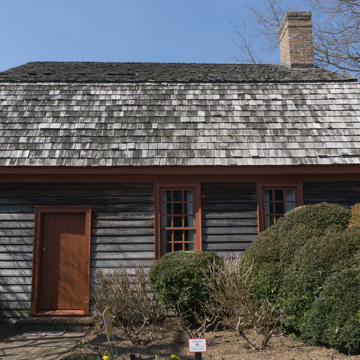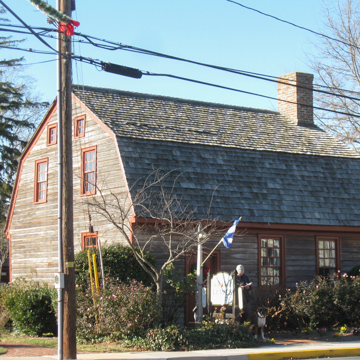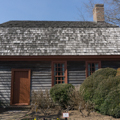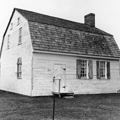This gambrel-roofed wooden house, one of the oldest surviving in Sussex County, originally stood at Cool Spring, six miles southwest of its present location. It was targeted for preservation around 1960 by historian Harold D. Eberlein (who called it White Meadow Farm, and “an architectural document of the first importance”) and state archivist Leon deValinger. Mabel Lloyd Ridgely, the Dover preservationist and a Fisher descendant, bought the decayed house and turned it over to the state. It was moved by truck to this location and now serves as an information center. Joshua Fisher, who prepared the first official charts of the Delaware Bay, inherited the Cool Spring property in 1713. After 1736, it was owned by the Martin family, who held it to 1959. The east part, until recently believed to date to 1728, is a two-bay, oak-framed structure with brick nogging. A molding of skinny dentils runs under the box eave, and the original siding was beaded. The house was expanded to the left by one bay, allowing the creation of a long stairhall, rather grand for such a tiny house. Historian Harold D. Eberlein was impressed by the dwelling's extremely simple “hall plan”—originally one room with a fireplace and winder stair—that was, he thought, a late medieval holdover. He called this type of plan “Resurrection Manor” for a Maryland house then thought to date to the 1650s and hence to be representative of practically the first phase of building in the colonies. But scholars today understand that the hall plan was a standard one for generations in the numerous, now-vanished, small wooden homes of the Tidewater.
You are here
Fisher-Martin House
If SAH Archipedia has been useful to you, please consider supporting it.
SAH Archipedia tells the story of the United States through its buildings, landscapes, and cities. This freely available resource empowers the public with authoritative knowledge that deepens their understanding and appreciation of the built environment. But the Society of Architectural Historians, which created SAH Archipedia with University of Virginia Press, needs your support to maintain the high-caliber research, writing, photography, cartography, editing, design, and programming that make SAH Archipedia a trusted online resource available to all who value the history of place, heritage tourism, and learning.






















